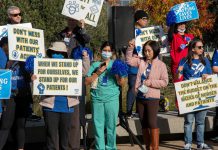Regional transportation authorities hope to align a Route 152
realignment project with the future California High-Speed Rail
system, members of a Route 152 Mobility Partnership learned
Friday.
Regional transportation authorities hope to align a Route 152 realignment project with the future California High-Speed Rail system, members of a Route 152 Mobility Partnership learned Friday.
Partnership members, including Mayor Al Pinheiro and Santa Clara County Supervisor Don Gage, discussed those plans while meeting Friday at Gilroy City Hall. The meeting marked the first time that the group of leaders from San Benito and Santa Clara counties has met publicly in Gilroy.
Eventually, Caltrans plans to realign Route 152 between U.S. 101 and Route 99 in the Central Valley. The Valley Transportation Authority and Council of San Benito County Governments formally created a memorandum of understanding Oct. 15 regarding a portion of the project that connects Route 156 to U.S. 101.
That portion of the project is expected to cost $215 million to $284 million, according to the San Benito COG. Others estimate the project will cost as much as $500 million. The VTA has secured $10 million for the project thus far, including $5 million of its own money and $5 million from the state. John Ristow, chief Congestion Management Agency officer for the Santa Clara Valley Transportation Authority, estimated after the meeting that the entire 82-mile project between U.S. 101 and Route 99 is likely to cost well more than $1 billion.
The two-lane portion of Route 152 between Route 156 and U.S. 101 is a major bottleneck and the scene of many accidents – 1.4 times higher than state average – Lee said. Of the 84 people who lost their lives on Route 152 between 2003 and 2008, 26 died in Santa Clara County.
The freeway also serves as a major corridor for goods movement between the Central Valley, the San Francisco Bay Area and the Monterey Bay Area, Lee said. By 2015, portions of the highway will exceed capacity, he said. The closest east-west corridors are Route 580, which stands 60 miles north, and Route 46, which is 120 miles south.
Any realignment of Route 152 would have to contend with flood plains in Santa Clara and San Benito counties, maps indicate.
Meanwhile, talks between the California High-Speed Rail Authority have been ongoing for the past six months, and the authority has been able to respond to alignment questions within the past month, Ristow said. High-speed rail authority officials generally have focused on Gilroy-area routes that either run through downtown or run east of U.S. 101.
“The option to cross over the high-speed rail is there, but environmentally that’s not as desirable,” realignment project manager Tim Lee said.
Ristow was optimistic, though.
“There’s a lot of unknowns yet, but I think the good thing is we can find a place to match up these alignments,” he said.
Gilroy’s City Council has requested that the high-speed rail system run through downtown in a trench, Pinheiro said. However, he said after the meeting that he also would like to see a study of high-speed rail’s economic impacts on downtown as well as studies on traffic impacts.
“We’ve got to be very careful to what we do with downtown,” Pinheiro said.
Attorney Joe Thompson – who has been a vocal critic of the high-speed rail project and sued the Council of San Benito County Governments and the San Benito County Board of Supervisors over alleged Brown Act violations relating to the realignment project – said the project is another example of bad government and bad planning.
The COG and board of supervisors have corrected a couple of the suit’s causes of action by opening Mobility Partnership meetings to the public and granting a Public Records Act request, he said. However, he said taxpayers’ constitutional rights are being deprived because San Benito COG and the VTA do not have any publicly elected representatives.
He also emphasized using private money for goods movement, such as through railroads, rather than using public tax dollars.
“This is the wrong way to approach transportation planning,” Thompson said.
The Mobility Partnership will next meet sometime in March or April. A traffic and revenue study will likely be complete at that time, Ristow said.















